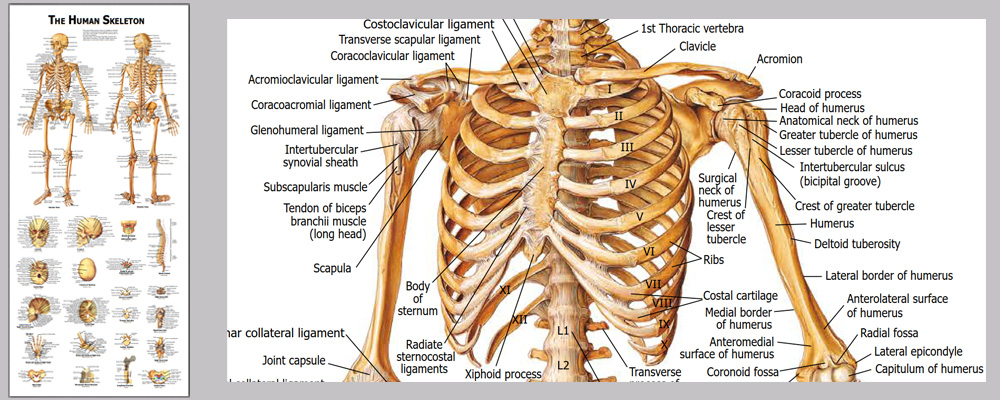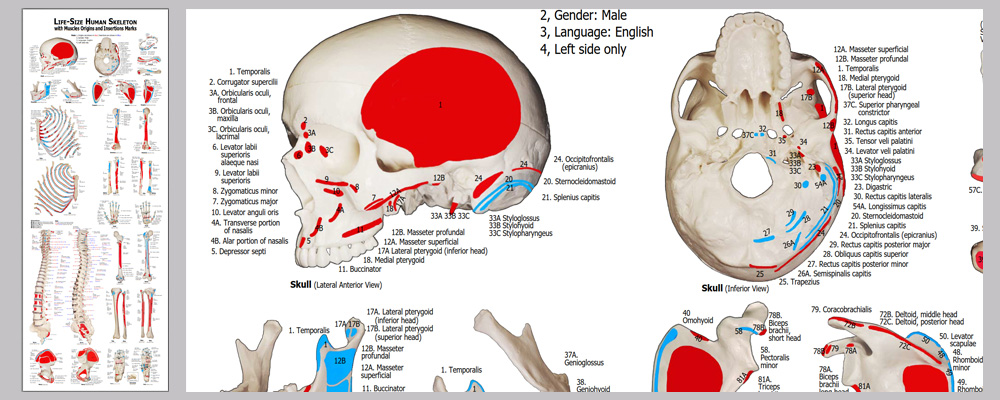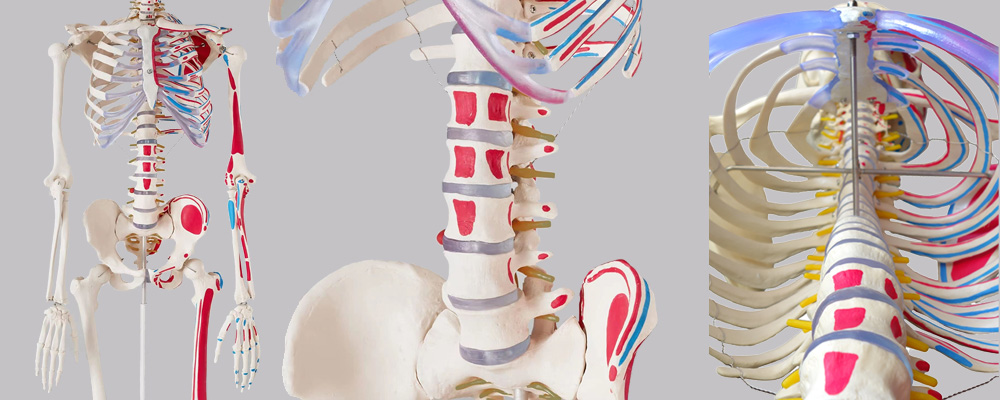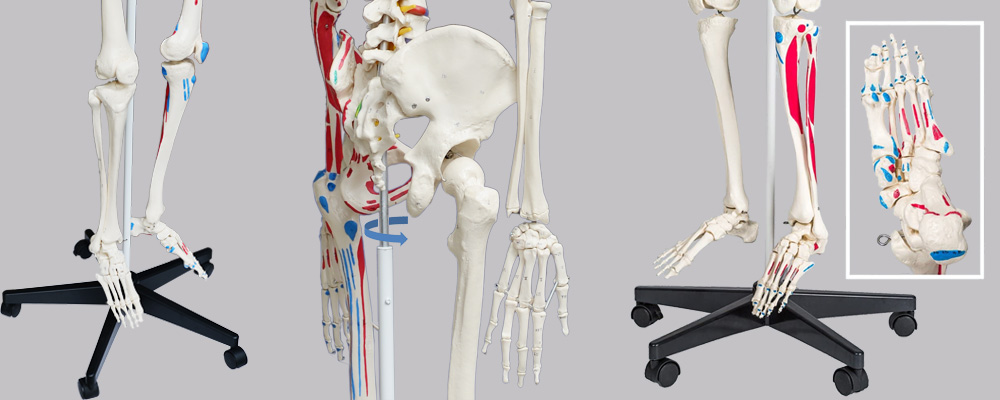open human skeleton model
This life size articulated adult human skeleton model is 180cm tall & ideal for teaching / learning the basics of human anatomy. Includes a colorful Human Skeleton chart to show all the detailed structures for reference.Detailed colorful chart with over 630 accurate definitions. Durable and no reflection with matte film covered, 36 * 78cm

Detailed muscles origins and insertions with codes. Durable and no reflection with matte film covered, 100cm * 38cm

Stainless steel wires keep the ribs gaps stable.

2 of 5 casters are lockable.

An overview of JC anatomy advantages: • Hand-painted muscle origins and insertions • Flexible spine and ligaments • Slipped disc between the 3rd and 4th lumbar vertebrae • Protruding spinal nerves and vertebral arteries • 3-part assembled skull with individually inserted teeth • Made from a durable, unbreakable synthetic material • Top quality, life size natural casting • lMultiple Applications -Acupuncturists,doctor,doctor, etc. • lChart - Detailed colorful chart with about 751 accurate definitions. Durable and no reflection with matte film covered, 36 * 78cm • On a stable metal stand with 5 casters (painted white) • Full size dust cover keeps model clean while in storage • Exceptional value for money with a 3 year guarantee • open human skeleton model Easy to use - Main joints are movable. Skull, skullcap arms, legs, crus, feet are removable.
| Product name | open human skeleton model |
| Place of Origin | Shenzhen China |
| Product Material | PVC, ABS, SST |
| Rib cage | A 5mm dia |
| Human skeleton model life | 20years |
| Surface treatment | Polish. Etched. Texture |
| SUPPORT 24/7 | Contact us 24 hours a day, 7 days a week |
| Size | 52 * 26 * 142 |
| Port | Shenzhen |
| PAYMENT & ORDERING | PayPal account or pay by credit card |
open human skeleton model FAQs Guide Are you looking for a quick review guide about open human skeleton model? An ultimate FAQs buying guide is available to help you.This guide contains all the information about all the important facts, figures, and various processes regarding open human skeleton model. Let’s continue!
2.open human skeleton model Can it be used to show the differences in body structure between children and adults?
3.About open human skeleton model production capacity
4.How can a open human skeleton model be utilized for rehabilitation and physiotherapy purposes?
5.What are the different types of open human skeleton model available?
6.open human skeleton model Can it be used as a teaching aid?
7.Can the open human skeleton model display many different body poses?
8.Does this open human skeleton model include all human skeletal systems?
9.Is it possible to disassemble different parts of this open human skeleton model?
10.What kind of material is used to make the open human skeleton model?
11.How many thoracic and lumbar vertebrae are there in the open human skeleton model?
12.Can this open human skeleton model be used as a simulation tool for sports training?
1.Can the open human skeleton model be disassembled and assembled to facilitate learning and display?
Yes, many human skeleton models are designed to be disassembled and assembled for educational purposes. The bones are typically connected by metal or plastic clips that can be easily removed and reattached, allowing for the skeleton to be taken apart and put back together. This feature makes the model useful for learning about the different bones and their connections, as well as their placement in the body. Students can learn the names and locations of each bone by taking them apart and reassembling them in the correct order. This hands-on approach can be helpful for visual learners and can make the learning process more engaging and interactive.
2.open human skeleton model Can it be used to show the differences in body structure between children and adults?
Yes, a human skeleton model can be used to clearly demonstrate the differences in body structure between children and adults. Here are some specific examples of how a skeleton model can be used to illustrate these differences: Size and proportion: One of the most evident differences between children and adults is their size and proportion. A skeleton model can be used to compare the relative sizes of different bones in a child and adult, such as the skull, spine, and limbs. Children have smaller and more delicate bones compared to adults, and their proportions also differ. For example, the head and skull of a child are proportionally larger to their body compared to an adult. In conclusion, a human skeleton model is an effective educational tool to showcase the differences in body structure between children and adults. Its three-dimensional design and ability to highlight specific bone structures make it an excellent visual aid to help understand the changes that occur during growth and development.
3.About open human skeleton model production capacity
600pcs each month
4.How can a open human skeleton model be utilized for rehabilitation and physiotherapy purposes?
Demonstrate the right bone parts postion relationships can help doctors and patients to understanhuman skeleton model can be a valuable tool for rehabilitation and physiotherapy purposes as it can aid in teaching and demonstrating proper body mechanics, identifying and addressing musculoskeletal imbalances and dysfunctions, and monitoring progress in treatment. Here are some ways in which a human skeleton model can be utilized for rehabilitation and physiotherapy purposes: 1. Education: A human skeleton model can be used to educate patients and clients about the structure and function of the human body. This can help them understand their injuries or conditions better, and also make them more aware of how their body moves and functions. 2. Creating personalized treatment plans: With the help of a skeleton model, therapists can design personalized treatment plans for each individual patient. This can include exercises and movements targeted at specific areas of the body that need strengthening or stretching.d the right way of rehabilitation and physiotherapy.
5.What are the different types of open human skeleton model available?
1. Anatomical Skeleton Models: These models are exact replicas of the human skeletal system and are used for educational and medical purposes. They are typically made of high-quality materials such as plastic or resin and come with detailed labels for each bone, making it easy to identify and study different structures. 2. Disarticulated Skeleton Models: These models consist of individual bones that can be separated from each other. They are often used in classrooms for teaching purposes as they allow students to handle and study each bone individually, facilitating a more hands-on learning experience. 3. Flexible Skeleton Models: These models are made from a flexible material such as rubber or PVC and are designed to mimic the movements of the human body. They are often used in medical training and rehabilitation settings to demonstrate muscle and joint movements. 4. Life-size Skeleton Models: As the name suggests, these models are the same size as an actual human skeleton. They are most commonly used in medical schools and hospitals for teaching and training purposes.
6.open human skeleton model Can it be used as a teaching aid?
Yes, a human skeleton model is a commonly used teaching aid in various academic fields such as anatomy, biology, and medical education. It is an accurate and detailed representation of the human skeleton, providing a visual aid for students to understand and grasp the complexities of the skeletal system.
7.Can the open human skeleton model display many different body poses?
The Human skeleton model can display many different body poses in order to show the movement and positioning of bones and muscles. The model can be manipulated into a range of poses such as the classical anatomical position, where the arms are down by the sides, palms facing forward, and feet shoulder-width apart. It can also be posed to demonstrate actions such as walking, running, jumping, and sitting. The flexibility of the model allows for a wide range of movements to be shown, from simple movements of individual joints to complex combinations of actions involving multiple joints. Additionally, the model can display different body poses by adjusting the positions of individual bones and joints. For example, the arms can be raised or lowered, the elbows bent or straightened, and the fingers spread or closed. The legs can be straightened or bent at the knee, and the ankles can be rotated to show different directions of movement. These adjustments allow for a variety of poses to be demonstrated, from relaxed positions to more dynamic and active positions. In summary, the Human skeleton model can display a wide variety of body poses and movements, ranging from simple to complex, to showcase the functions and interactions of the bones and muscles in the human body.
8.Does this open human skeleton model include all human skeletal systems?
It depends on the model in question. Some Human skeleton models may include all human skeletal systems such as the axial skeleton (skull, vertebral column, ribcage), appendicular skeleton (arms, legs, shoulder girdle, pelvic girdle), and cartilaginous skeleton (cartilaginous structures such as the nose and ears). However, others may only include certain systems or be limited to specific areas of the body. It is important to carefully read the product description or ask the manufacturer for a detailed list of what is included in the model to ensure that it meets your needs.
9.Is it possible to disassemble different parts of this open human skeleton model?
It's easy to disassemble the whole model into some sub-assemblies - Skull, torso, extremities, etc toollessly. The model can be disassembled into more pieces with tools (Not recommended)
10.What kind of material is used to make the open human skeleton model?
The human skeleton model is typically made out of a combination of materials, depending on the specific model and its intended use. Generally, the main materials used are plastic, metal, and sometimes, natural materials such as wood. Plastic: The majority of the skeleton model is made from a high-quality, durable plastic such as polyvinyl chloride (PVC) or polyethylene. These materials are lightweight and easy to mold into the intricate and specific shapes required for each bone in the skeleton. They are also easy to paint and can be colored to resemble real bones.
11.How many thoracic and lumbar vertebrae are there in the open human skeleton model?
There are 12 segments in the thoracic vertebrae, 5 segments in the lumbar vertebraeGenerally, there are 12 thoracic vertebrae and 5 lumbar vertebrae in the human skeleton model. The thoracic vertebrae are located in the middle region of the spine, between the cervical vertebrae (neck) and lumbar vertebrae (lower back). They are numbered from T1 to T12, with T1 being the first thoracic vertebra closest to the skull and T12 being the last thoracic vertebra closest to the pelvis. The lumbar vertebrae are located in the lower back region, below the thoracic vertebrae. They are numbered from L1 to L5, with L1 being the first lumbar vertebra closest to the thoracic vertebrae and L5 being the last lumbar vertebra closest to the sacrum (a triangular bone at the base of the spine). However, the specific number of thoracic and lumbar vertebrae may vary slightly from person to person due to individual differences in bone structure. Some people may have 11 or 13 thoracic vertebrae, and 4 or 6 lumbar vertebrae. This is known as a variation or anomaly in the number of vertebrae. .
12.Can this open human skeleton model be used as a simulation tool for sports training?
The Human skeleton model can definitely be used as a simulation tool for sports training. This model can be used in various ways to simulate different scenarios and movements that are specific to different sports. In conclusion, the Human skeleton model is a versatile tool that can be used to enhance sports training in various ways. It can help athletes and coaches understand and improve technique, prevent injuries, analyze and correct movement patterns, and simulate specific sports movements and scenarios. Thus, it can be a valuable resource for individuals looking to train and improve their performance in sports.




